
Acacia koa, commonly known as koa, is a species of flowering tree in the family Fabaceae. It is endemic to the Hawaiian Islands, where it is the second most common tree. The highest populations are on Hawaiʻi, Maui and Oʻahu.

The ʻiʻiwi or scarlet honeycreeper is a species of Hawaiian honeycreeper. The ʻiʻiwi is a highly recognizable symbol of Hawaiʻi. The ʻiʻiwi is one of the most common endemic birds of the Hawaiian Islands.

ʻAkaka Falls State Park is a state park on Hawaiʻi Island, in the U.S. state of Hawaii. The park is about 11 miles (18 km) north of Hilo, west of Honomū off the Hawaii Belt Road at the end of Hawaii Route 220. It includes its namesake ʻAkaka Falls, a 442-foot (135 m) tall waterfall. ʻAkaka is named after Chief 'Akaka-o-ka-nī'au-oi'o-i-ka-wao, grandson of Kūlanikapele and Kīakalohia. The accessible portion of the park lies high on the right shoulder of the deep gorge into which the waterfall plunges, and the falls can be viewed from several points along a loop trail through the park. Also visible from this trail is Kahūnā Falls, a 300-foot (91 m) tall waterfall, and several smaller cascades.
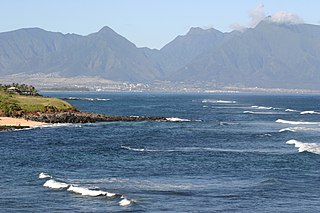
Puʻu Kukui is a mountain peak in Hawaiʻi. It is the highest peak of Mauna Kahalawai. The 5,788-foot (1,764 m) summit rises above the Puʻu Kukui Watershed Management Area, an 8,661-acre (35.05 km2) private nature preserve maintained by the Maui Land & Pineapple Company. The peak was formed by a volcano whose caldera eroded into what is now the Iao Valley.

The Hawaiian tropical rainforests are a tropical moist broadleaf forest ecoregion in the Hawaiian Islands. They cover an area of 6,700 km2 (2,600 sq mi) in the windward lowlands and montane regions of the islands. Coastal mesic forests are found at elevations from sea level to 300 m (980 ft). Mixed mesic forests occur at elevations of 750 to 1,250 m, while wet forests are found from 1,250 to 1,700 m. Moist bogs and shrublands exist on montane plateaus and depressions. For the 28 million years of existence of the Hawaiian Islands, they have been isolated from the rest of the world by vast stretches of the Pacific Ocean, and this isolation has resulted in the evolution of an incredible diversity of endemic species, including fungi, mosses, snails, birds, and other wildlife. In the lush, moist forests high in the mountains, trees are draped with vines, orchids, ferns, and mosses. This ecoregion includes one of the world's wettest places, the slopes of Mount Waiʻaleʻale, which average 373 in (9,500 mm) of rainfall per year.

The ʻōʻū is a species of Hawaiian honeycreeper endemic to the Hawaiian islands. It has a dark green back and olive green underparts; males have a yellow head while females have a green head. Its unusual beak seems to be adapted to feeding on the fruits of Freycinetia arborea. It has a strong flight which it uses to fly considerable distances in search of this vine, but it will eat other fruits, buds, flowers and insects.

Acacia koaia, known as koaiʻa or koaiʻe in Hawaiian, is a species of acacia that is endemic to Hawaii. It is closely related to koa, and is sometimes considered to be the same species.
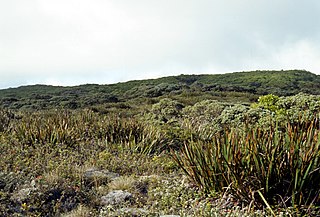
Pēpēʻōpae is a bog on the island of Molokaʻi in Hawaii.
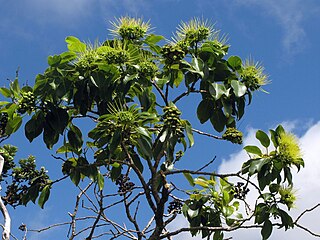
Metrosideros macropus, the lehua mamo or 'ohi'a, is a species of tree in the eucalyptus family, Myrtaceae. It is endemic to the island of Oʻahu in the Hawaiian Islands. It is closely related to the widespread and highly variable ʻōhiʻa lehua, found throughout the islands. Lehua mamo, however, is only found in the Koʻolau mountains. It is distinguished from M. polymorpha by the elongate leaf petioles and the flowers are usually yellow. The latter character is also found in some varieties of M. polymorpha, which normally has red flowers, but occasionally the flowers of M. macropus are red as well.

The ʻanianiau is a species of Hawaiian honeycreeper that is endemic to upper elevation forests on the island of Kauai.

The Hawaiʻi ʻamakihi, also known as the common ʻamakihi, is a species of Hawaiian honeycreeper.

The Hawaiʻi creeper, Hawaii creeper or ʻalawī is a species of Hawaiian honeycreeper endemic to the Big Island of Hawaiʻi. Its natural habitats are dry forests and montane moist forests at elevations of 1,000–2,300 metres (3,300–7,500 ft). There are a total of 12,000 birds separated into three populations. A fourth population on the western part of the island probably represents migratory birds from one of the existing population. The Hawaiʻi creeper measures 4.5 inches (11 cm) and has drab green plumage. In 2017 the traditional Hawaiian name was rediscovered as 'alawi'.

The ʻākohekohe, or crested honeycreeper, is a species of Hawaiian honeycreeper. It is endemic to the island of Maui in Hawaiʻi. The ʻākohekohe is susceptible to mosquito‐transmitted avian malaria and only breeds in high‐elevation wet forests.
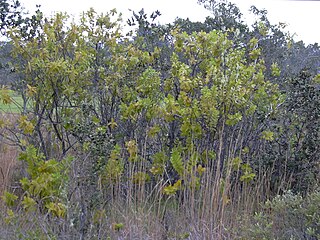
Hawaiian tropical dry forests are a tropical dry broadleaf forest ecoregion in the Hawaiian Islands. They cover an area of 6,600 km2 (2,500 sq mi) on the leeward side of the main islands and the summits of Niʻihau and Kahoʻolawe. These forests are either seasonal or sclerophyllous. Annual rainfall is less than 127 cm (50 in) and may be as low as 25 cm (9.8 in). The rainy season there lasts from November to March.

Pleomele is a former genus of flowering plants. All its species are now placed in the genus Dracaena. The Hawaiian name for plants in this genus is hala pepe, which translates to crushed or dwarfed Pandanus tectorius.
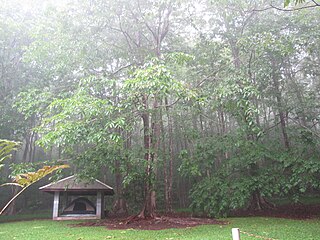
The Kalōpā Native Forest State Park and Recreation Area is a state park with an arboretum of native trees located approximately 40 mi (64 km) northwest of Hilo, near the village of Honokaʻa, a few miles inland from the Mamalahoa Highway section of the Hawaii Belt Road, Island of Hawaiʻi, Hawaiʻi.
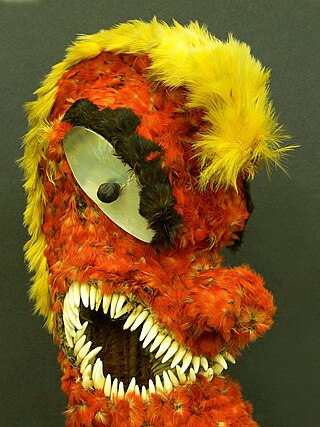
In Hawaiian religion, Kū is one of the four great gods. The other three are Kanaloa, Kāne, and Lono. Some feathered god images or akua hulu manu are considered to represent Kū. Kū is worshiped under many names, including Kū-ka-ʻili-moku, the "Snatcher of Land". Rituals for Kūkaʻilimoku included human sacrifice, which was not part of the worship of other gods.
Silene hawaiiensis is a rare species of flowering plant in the family Caryophyllaceae known by the common names Hawai'i catchfly, Hawaiian catchfly and Sherff's catchfly. It is endemic to Hawaii, where it is known only from the island of Hawaii. It is threatened by the degradation of its habitat and it is a federally listed threatened species of the United States.
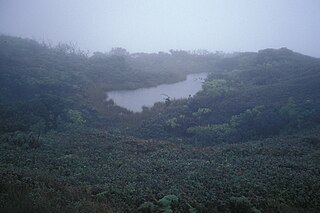
Violet Lake, is a small high-elevation lake located at 5,020 ft (1,530 m) above sea level on Mauna Kahalawai, situated in the western part of the island of Maui. It is located in the boggy slopes near the ʻEke Crater and Puʻu Kukui, the highest peak of the West Maui Mountains. It is approximately 10 ft × 20 ft in size.
Ruth Leilani Stemmermann, also known as LaniStemmermann, was an assistant professor of plant ecology, biology and environmental science at the University of Hawaiʻi at Mānoa (UHM) and Hawaiʻi Community College in Hilo. Stemmermann was a botanist dedicated to the research and preservation of Hawai'i's vegetation, chiefly known for her triumph in a lawsuit against the U.S. Army to protect native plants in the Pohakuloa Training Area. In 1990, Stemmermann collaborated with Stanford University and became the co-principal of the National Science Foundation project known as the "Ecosystem Dynamics in Hawaiʻi" which allowed her to establish a Common Garden to study the native rainforest trees, now known as the Stemmermann Common Garden.























